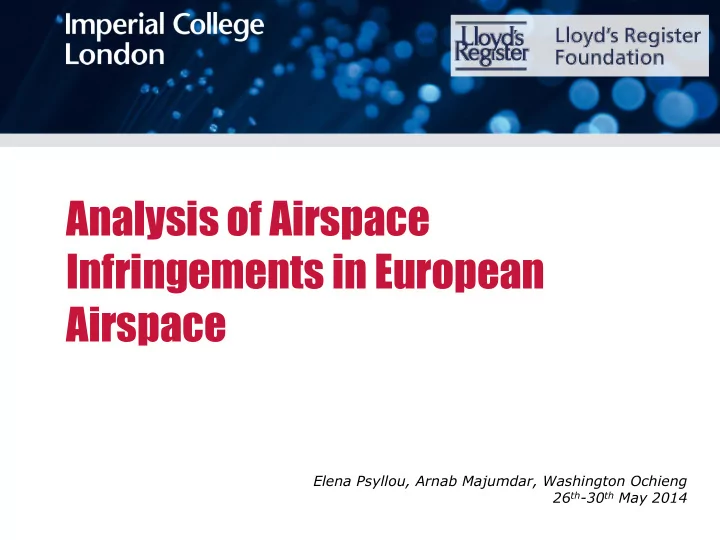

Analysis of Airspace Infringements in European Airspace Elena Psyllou, Arnab Majumdar, Washington Ochieng 26 th -30 th May 2014
My Background 2012 – Now Research student in aviation safety at Lloyd's Register Educational Trust Transport Risk Management Centre, Centre for Transport Studies 2011 – 2012 MSc in Transport from Imperial College and UCL 2007 – 2011 Undergraduate degree in Civil Engineering from Cyprus University of Technology Motive: Helios crash in Athens 2005 • 121 fatalities (93 adults, 22 passengers are children and teenagers)
Outline of Presentation • Definition of Airspace Infringements (AIs) • Studies by EUROCONTROL • Proposed methodology • Results • Conclusions
What is an Airspace Infringement (AI)? S o u t h e r n N o r w e g i a n a i r s p a c e Controlled airspace Oslo TMA Uncontrolled airspace ENDM CTR ENJB Farris TMA AIP Norway Avinor
Consequences • No problem to controllers and traffic in controlled airspace • Delays • Loss of separation with other traffic and high risk of a mid-air collision FlyOnTrack Website
European Statistics • Frequency of incidents • Impact on safety • Unclassified/Not determined incidents Safety Regulation Commission (2012)
Studies by EUROCONTROL Part I: Safety Analysis of Airspace Part II: General aviation airspace Part III: Case study Infringements in Europe 2007 infringement survey 2007 Switzerland Data Safety data X X GA pilot survey/ discussion X X Methodology Incident analysis X X Frequency analysis X X X Severity analysis X X Findings Detailed factors X Correlations X Scenarios X X Insufficient information X X
Aims of this Presentation Development of a robust safety analysis methodology for AIs involving GA in Europe using incident reports
Methodology Coding dataset Quality assessment of the data Descriptive statistics of AIs Associations between Identification of contributory factors contributory factors Combined model Frequency analysis of contributory factors Design of severity models
Avinor safety data (2008-2012) CA CASE SE STU STUDY DY
Quality Assessment Relevance 100 80 60 40 20 Accessibility % 0 -100 -80 -60 -40 -20 0 20 40 60 80 100 -20 Completeness -40 -60 -80 Consistency -100
Descriptive Statistics • 88% incidents: Infringing aircraft • 80% incidents: GA aircraft VFR • 75% incidents: En-route flight phase • 54% incidents: Airspace Class D • 31% incidents: Airspace Class C • 70% incidents: Pilot is involved
Phenomenon of Seasonality
Location of Incidents • Location related to: • Quality of flight plan • Two-way radio contact Northern 21% Bodo Southern 79% Oslo
Two-way Radio Contact
Causal Category Airspace Infrignement - Causal category Environmental 3% Equipment 11% Pilot naviagation Controller skills skills 19% 46% Pilot communication skills 21% Quality of flight plan • Inadequate knowledge of navigation: • Airspace structure • Airspace procedures • Airspace boundaries •
CO COMBINED INED MODE DEL
Stage I: Ranking Contributory Factors Ranking Contributor Frequency 1 No/Poor radio contact 317 2 Use of wrong frequency 68 3 No/Poor of Flight Plan 58 4 Inadequate knowledge of airspace boundaries 56 5 Inadequate knowledge of airspace procedures 49 6 Loss of awareness 47 7 Unfamiliar airspace and/or route 45
Stage II: Severity Models • Two models: • Safety effect on aircraft involved • Safety effect on ATM • Binary discrete choice models • Binary depended variable = likelihood of each category (a) of variable • 0 “no impact” ESARR class D and E • 1 “ significant ” ESARR class A, B and C 𝑄 𝑗 𝑄 𝑗 𝛾 𝛾 𝑦 ⋯ 𝛾 𝑙 𝑦 𝑙 − 𝑄 𝑗 𝑄 𝑗 Logit 𝑄 𝑗 a = LN = 𝛾 0 + 𝛾 1 𝑦 1 + ⋯ + 𝛾 𝑙 𝑦 𝑙 (1) 1 − 𝑄 𝑗 exp 𝛾 0 + 𝛾 1 𝑦 1 + … + 𝛾 𝑙 𝑦 𝑙 𝑄 𝑗 𝑏 = 1 + exp 𝛾 0 + 𝛾 1 𝑦 1 + … + 𝛾 𝑙 𝑦 𝑙 (2) 𝛾 𝛾 𝑙 𝑦 𝑙 𝛾 𝑦 … 𝑄 𝑗 𝑏 = 𝛾 𝛾 𝑙 𝑦 𝑙 𝛾 𝑦 …
Safety Effect on Aircraft Involved Binary logistic regression model (Level of confidence 95%) 2008-2011 data Parameter Value Odds Significance Intercept -0.788 0.455 0.036 Pilot is involved 1.588 4.893 0.004 Summer period 0.321 1.379 0.321 Location of incident (South) 0.738 2.092 0.007 Inadequate knowledge of -0.662 0.516 0.095 airspace procedures
Safety Effect on ATM Service Binary logistic regression model (Level of confidence 95%) 2008-2011 data Parameter Value Odds Significance Intercept -1.984 0.137 0 Summer period 0.925 1.572 0.43 No/Poor flight plan 0.925 2.522 0.082 No/Poor radio contact -0.428 1.535 0.233
Conclusions • Qualitative and quantitative analysis for high-quality data • Factors related to navigation and communication skills of pilots are found in Avinor data • Quality of flight plan • Knowledge of airspace boundaries • Establishment of two-way radio contact • Directly useful for Avinor • e.g. southern Norway, spring time • Pilot’s performance when they fly near to the boundary of controlled airspace using new VFR flight planning and navigation software • Further research • Understand general aviation pilot’s factors by discussing with pilots, flight instructors and other stakeholders and observations Thank you for your attention!
Recommend
More recommend